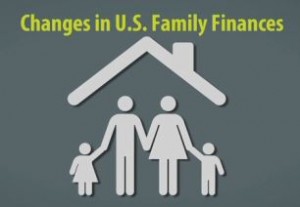The ‘average’ U.S. family is doing just fine, suggests the Federal Reserve’s latest triennial portrait of household wealth. But typical Americans are struggling something awful. Could both be true?
By Sam Pizzigati
 [1]
[1]The latest triennial Survey of Consumer Finances from the Federal Reserve comes complete with an introductory video [2].
Every three years, America’s Federal Reserve Board surveys just how well the nation’s families are doing economically. The Fed takes this surveying seriously.
We’re not talking quickie public opinion polling here, several hundred dinner-time phone calls that last a few minutes each. The over 6,000 interviews the Fed conducts for its Survey of Consumer Finances usually run for an hour and a half, and most get conducted in person. These interviews delve into every aspect of our modern economic existence, from monthly car payments to mutual funds.
The latest Federal Reserve Survey of Consumer Finances report, released last Thursday, covers the entire period from 1989 through 2013. The report’s new numbers essentially offer up the most detailed economic portrait yet of American family finances over the last quarter-century.
The picture the new Fed numbers paint, some might argue, doesn’t look all that bad. Take family net worth, for instance.
Back in 1989, after adjusting for inflation, the average American family had $336,100 more in assets than liabilities. Last year, American family net worth averaged $534,600, an impressive 59 percent increase over the 1989 figure.
The growing wealth of America’s affluent is driving up America’s average family net worth.
So the American economy must be working, right?
Working? Sure, but only for the affluent. The growing wealth of these affluent, the new Fed data show, is driving up America’s average family net worth. But straight averages can mislead — and even deceive. If nine people each have zero net worth and a tenth person holds a fortune worth $10 million, the average person in that 10-person group will be a millionaire.
Medians, by contrast, tell us more about how everyday people are truly faring. At the median point, half the people in any distribution have more, half less. In 1989, the new Fed Survey of Consumer Finances details, the median — most typical — U.S. family held $84,800 in net worth, after adjusting for inflation.
In 2013, America’s most typical families held only $81,200, 4 percent less.
In other words, the typical American family is moving economically in reverse, losing wealth. And if we drill down into specific income brackets, the losses in family net worth become even more pronounced.
Families in America’s statistical middle class — the nation’s middle 20 percent of income earners — held a median net worth of $75,300 in 1989. This middle’s median net worth in 2013: $61,700, an 18 percent dropoff.
The typical American family is moving economically in reverse.
Up at the nation’s income summit, a different story. America’s top 10 percent of income earners — families that pulled in over $154,600 in 2013 — saw their median household net worth rise 61 percent, to $1,130,700, in the quarter-century that ended last year.
How much did top 1 percent wealth rise during that span? The new Federal Reserve Survey of Consumer Finances report doesn’t break down a top 1 percent figure. But the Fed does supply some revealing numbers for the top 3 percent.
This lofty cohort, the new Fed report notes, pulled down 44.8 percent of the nation’s wealth in 1989, 51.8 percent in 2007, and 54.4 percent in 2013.
Actually, the top 3 percent pulled in a higher share of America’s net worth than the Fed numbers indicate. The reason: The Fed’s wealth totals do not reflect any of the wealth of America’s 400 richest.
Fed researchers, for “confidentiality” reasons, purposefully do not take these top 400 fortunes into account.
 [3]“Persons listed by Forbes magazine as being among the wealthiest 400 people in the United States,” the new Survey of Consumer Finances acknowledges, “are excluded from sampling.”
[3]“Persons listed by Forbes magazine as being among the wealthiest 400 people in the United States,” the new Survey of Consumer Finances acknowledges, “are excluded from sampling.”
Forbes will release its latest annual listing of America’s 400 richest individuals at the end of this month. Last September, Forbes reported that those 400 richest held a combined fortune [4] worth $2.02 trillion.
The combined fortune of 400 typical American families last year? A bit over $32 million. How many groups of 400 typical American families would we have to assemble to equal the $2.02 trillion of the Forbes 400? Just over 62,000.
Sam Pizzigati edits Too Much [5], the Institute for Policy Studies online weekly on excess and inequality. His latest book: The Rich Don’t Always Win: The Forgotten Triumph over Plutocracy that Created the American Middle Class [6] (Seven Stories Press).